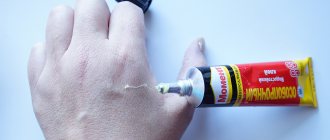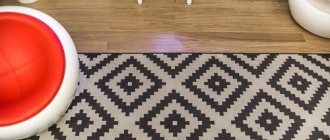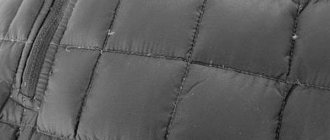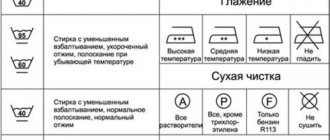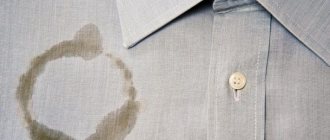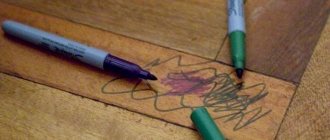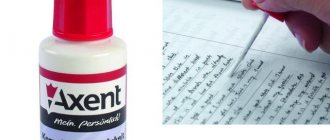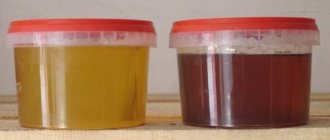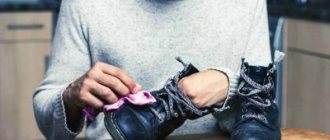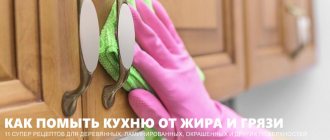Difficulty removing glue
“Moment” received its name for a reason - this adhesive composition is instant in setting, quick-drying and very durable. In a few seconds, the glue impregnates the fibers of loose material or firmly adheres to a dense base. This effect is achieved due to the presence of cyanoacrylate and other components - adhesion enhancers. They allow you to reliably fasten even non-porous substrates.
You need to work with Moment or Moment-Crystal glue carefully and always wear gloves. If the product gets on an unintended surface or on your hands, a stain will immediately appear, which is difficult to wash off even when fresh. It is especially difficult to remove drops from clothing and other fabrics. When cleaning, a hole may appear or the material will become rigid, hard, and then begin to crumble along with adhesive drips.
A distinctive property of “Moment” is its resistance to water – cold and hot. Therefore, it will not be possible to simply wash off the dirt without using additional products. The glue is also capable of filling the slightest cracks, pores, and the skin of the hands has a porous structure. This explains the difficulty of removing glue stains from your hands. Sometimes an attempt to break fingers glued together ends in the appearance of a wound. To remove stains, you need to use special methods.
Introduction to the topic
Adhesive mixtures have high strength, firmly fix the glued fragments and dry quickly. Therefore, it is recommended to immediately wipe off excess glue with a dry cloth. If contamination is not noticed immediately, the stain will be difficult to remove without damaging the surface.
Before wiping off liquid nails, you need to find out the composition of the adhesive substance, taking into account the following features:
- The solvent-based product has improved adhesive properties, emits a sharp, specific odor, and firmly bonds any surface.
- Water-based glue is environmentally friendly and does not have a specific odor, but it glues objects less efficiently and does not last as long.
- To choose a suitable remover and remove residual liquid nails, you need to carefully read the characteristics of the composition on the packaging and the manufacturer’s instructions for removing glue.
To effectively wipe off liquid nails, manufacturers of adhesive products recommend purchasing a special remover along with the polymer sealant. This is not a waste of money, but a quick solution to the problem of how to dissolve liquid nails. The cleaner dissolves dried glue well, after which the softened product is easy to remove from the surface.
Attention! To remove glue, you can use improvised means or solvents. A fresh stain that you notice immediately can be easily washed off with warm water and a foam sponge.
Mechanical method
If a trace of glue appears on the skin of the body, hands or surrounding objects, you can first try mechanical cleaning. To slightly reduce the adhesion of “Moment” to the epidermis, you should first steam your hands. To do this, prepare a solution:
- pour hot water into the basin;
- add a little glycerin;
- add sea salt;
- add a teaspoon of citric acid (about 3-4 liters of water).
Place your fingers in the water and hold for 15 minutes. Afterwards it will be easier to remove the glue from the skin. A small stain can be removed by prolonged washing or treatment with pumice. A scrub is also useful; it contains abrasive particles that help cleanse the skin. It is advisable to steam your hands first so that the remnants of the “Moment” are removed faster. We must remember that steamed skin can be easily damaged, so you should be careful when using pumice! After all manipulations, it is recommended to apply a nourishing cream to the skin.
conclusions
A concrete surface is considered clean if there are no foreign substances present on it that could reduce the adhesion strength of concrete to any coating. Cleaning can be done chemically or mechanically. Mechanical cleaning is quite labor-intensive and requires the use of special equipment or a large number of human resources . When using a chemical method, difficulties often arise associated with controlling the depth of the split layer. Very often, chemical cleaning is carried out in combination with mechanical cleaning, which significantly speeds up and facilitates the process.
The abrasive blasting method significantly increases the productivity of cleaning work, but its use generates a large amount of dust and secondary waste, which is not always acceptable from the point of view of labor safety. In terms of economic costs, waterjet cleaning is the most effective . This technology is also environmentally friendly. The use of water allows you to increase the efficiency and speed of cleaning by 1.5-2 times compared to the dry method.
Techniques for mechanically cleaning concrete from tile adhesive are discussed in the video:
We use improvised means
You can quickly remove glue stains using household products and home methods. For example, jeans and trousers can be placed in the freezer after placing them in a plastic bag. After freezing, the fabric must be carefully cleaned mechanically, and the remaining stains must be washed off by hand with powder. You may need to run the washing machine several times to get rid of the stain completely.
Another option for removing glue stains is to clean the surface with a citric acid solution. Add 20 g of powder to a liter of warm water, pour over the stain, and leave for 20 minutes. Then clean it with a hard sponge and wash it by hand. Instead of acid, it is permissible to use undiluted lemon juice.
There are other home methods to remove glue stains. If we are talking about fabric, it is important to look at the label: delicate materials can deteriorate from the action of certain components, and they can be washed at +20...+30 degrees or in cold water.
Soap solution
The easiest way is to wash a dress or clean a jacket with soapy water. It is necessary to dilute grated laundry soap in warm water so that the solution becomes thick. Place the item in the solution and leave for an hour. Then wash by hand until the stain comes off.
Salt
Salt works as a chemical agent and also acts mechanically as a scrub. Therefore, you can use it to remove the film of Momenta glue from your fingers, clean other areas of the skin, or even wipe off dirt from dishes, containers, tiles, and glass. You just need to take a pinch and rub the stain, after slightly moistening the area. You need to be careful; salt causes skin irritation for some people. After applying salt, rinse the treated area well with water.
Oil
“Moment” removes any vegetable oil well from nails, skin and even teeth. This option is inexpensive and effective, but it cannot be used on fabric or shoes; it cannot remove greasy stains. It is necessary to apply the oil to a cotton pad, wipe the contaminated area, and, if it is skin, leave for 10 minutes. Afterwards, wash off any remaining glue with soap and water. This method is great for cleaning baby's hands. It is also allowed to use fatty baby cream and Vaseline instead of oil.
Vinegar
To clean metal and wooden surfaces, you can use vinegar diluted with water. You need to take the essence, dilute it twice with water, and moisten the brush in the product. Rub the problem area with a brush. You can also pre-wipe the base with a vinegar solution, leave it under the film for 15 minutes, and then clean it. It is also possible to soak things in a vinegar solution that then need to be washed.
How to remove PVA?
Of all existing adhesives, PVA is the most susceptible to dissolution. The arsenal of tools that can be used to dissolve PVA glue includes the following materials:
- 1. hot soapy solution – when treating with this material, the surface should be washed with 9% acetic acid or 96% alcohol;
- 2. baking soda perfectly softens hardened residues; to get the result, you need to walk a hard sponge with soda over the PVA layer - it will be wiped off in a minute;
- 3. water softens the dried PVA clot, its soluble elements are separated from the emulsified suspension, the remains can be wiped off with a rag moistened with acetone, methanol, isobenzene or ethyl acetate.
Application of special chemistry
The most effective method of removing glue is the use of chemicals that are sold in hardware and construction stores.
Solvents
You can clean Moment stains from glass, tiles, and thick fabrics using solvents. You need to buy any organic solvent, moisten a cloth, and carefully wipe the surface of the product. After some time, the stain will go away and its remnants can be removed. When cleaning fabric, it is advisable to test the reaction to the solvent in an inconspicuous area.
Pure gasoline can be used as a means to dissolve the glue. It perfectly removes “Moment” from gloves, work clothes, and unpainted metal. A cotton pad dipped in gasoline is applied to the fabric, left for half an hour, then the product is washed.
Anticlean
“Anti-glue” is a special product that can “unstick” a seam made with almost any glue. It is sold in construction stores. Drop a little Anti-Glue directly from the bottle onto the contaminated area, wait until the reaction occurs, then wipe off the remaining product along with the dissolved Moment. If Anti-Glue was used to clean the fabric, it must be washed thoroughly afterwards. Using this product you can also remove glue from furniture, laminate, and linoleum.
Dimexide
The drug Dimexide is sold in all pharmacies. It not only heals, but is also used in an unconventional way - it dissolves “Moment”, superglue. You need to moisten a cotton pad in Dimexide and wipe metal and wood. The product can also be used to cleanse the skin of your hands, but it must be diluted twice with water.
Acetone
Acetone is a solvent, so it works in a similar way - it dilutes the structure of the glue and disrupts its adhesion to the surface. As a result, after wetting the stain, the glue can be removed with a brush. Typically, acetone or nail polish remover based on it is used to clean synthetic fabrics and metal. It is strictly forbidden to use them on wool, velvet, or natural silk; the items will be irrevocably damaged.
White Spirit
This aggressive solvent is designed to remove oil paint runs. It will also help dissolve the “Moment” if it gets on metal or glass bases. Contact with the body during work should be avoided; all actions should be performed with gloves.
How to remove glue from rhinestones on clothes
Some items decorated with stones and rhinestones begin to lose them after several washes. They leave behind unattractive and often yellowed traces of glue. You shouldn’t get upset ahead of time and write off such a thing, it’s still possible to save it.
Since you cannot remove super glue from clothes using the classic method, you can use the following instructions:
- Take a soldering iron.
- Heat the former locations of the rhinestones where the glue remains.
- After the substance begins to melt, its remnants can be removed with a small sharp metal object.
Remains of rhinestones on a T-shirt, which also look unattractive in appearance, can be removed using white spirit. The product must be applied from the inside of the fabric, wait a couple of minutes and then remove the rhinestones.
Methods for cleaning different surfaces
How to clean contaminated substrates depends on the type of material from which they are made. Most often you have to remove glue from the skin of your hands, nails, as well as from the table and floor.
How to remove “Moment” from your hands
People who repair shoes at home often encounter the problem of contaminating their hands with Moment. As soon as this happens, you should try to immediately wipe off the glue with oil. Any vegetable oil or butter will do. Rub your hand until the product is completely dissolved; if necessary, use a brush. At the end of the procedure, you need to wash your hands with laundry soap.
The following methods are also used against glue stains on hands:
- Wash by hand. Housewives practice this method against corrosive dirt on their hands. You need to dissolve the powder in water, take any item (preferably unnecessary), wash it thoroughly, working with your hands.
- Acetone. To remove stubborn stains, you can wipe your hands with acetone. It is only important to quickly wash off the solvent from the skin so that it does not have time to cause irritation. For nails, you can use acetone-containing nail polish remover.
- Nail file or for exfoliating skin, pumice. If you act carefully, it is quite possible to “cut off” the glue with a file without harming the skin. The main thing is to rub your hands carefully, without strong pressure.
Washing furniture made of wood, chipboard, MDF
There are similar products in every apartment, so during the renovation process they can get dirty with glue. Nail polish remover and acetone are excellent for removing marks from wooden surfaces. You just need to wipe the base with a sponge soaked in such substances. You cannot use acetone only on varnished surfaces; it is better to wash them carefully with laundry soap.
Fabrics and shoes
Use gasoline or acetone to remove Moment stains from coarse, thick fabrics, with the exception of wool. Wipe the material with a sponge soaked in such solvents. First, it is better to test the effect of the products on inconspicuous areas. Delicate fabrics should be washed with a solution of citric acid and wiped with lemon juice. After removing most of the glue, you can wash the item in the washing machine.
You can also remove stains in the following ways:
- freeze the product in the freezer, then separate the glue with nail clippers;
- attach paper to the item, iron it with an iron, the glue will be absorbed into the sheet after melting;
- take the item to the dry cleaner.
“Moment” is wiped off from the sole of the shoe using a cloth soaked in Dimexide or “Anticle”. From the outside, shoes can be cleaned with alcohol, mechanically (with a special brush), and washed with soapy water.
Washing the floor
When working with glue, drops of it can get on parquet, laminate, linoleum. Of course, you should initially cover the floor so as not to damage it, but if there is a problem, you can wash off unsightly marks with white spirit, Dimexide, or Anti-Glue. For parquet, it is better to use Dimexide diluted with water in half.
Metal cleaning
Metal surfaces can be cleaned of glue using acetone and acetone-based liquids. Gasoline, vinegar, and white spirit will also not harm unpainted metal. For painted products, it is better to use alcohol or vodka. The remains of the softened “Moment” can be cut off with a blade, a stationery knife, or cleaned off with salt or other abrasive.
Plastic laundering
It is difficult to remove glue from plastic, because this material is soft and has excellent adhesion to various adhesives. It is best to use the following methods:
- moisten a cotton pad with boiling water, apply to the stain, cover with cellophane on top, cut off the glue after an hour or carefully clean with a brush;
- make a soap solution, thoroughly rinse the area of contamination with a hard sponge and the prepared product;
- rub the area where the glue appears with alcohol, you can wait a while for the product to better soften;
- dissolve the glue with Dimexide, then wipe off the remaining residue with salt.
On some types of plastic you can use white spirit or acetone; there will be no harm to the surface, but you need to first check the reaction from an inconspicuous edge of the product.
Glass cleaning
Glue is removed from glass bases with vegetable oil. You can also use a detergent in powder form, salt, or baking soda. For glass surfaces it is permissible to use kerosene, acetone, and gasoline. Crystal products are effectively cleaned with ammonia.
Cost of work
When calculating the cost of cleaning concrete from tile adhesive, many factors are taken into account. The main ones are the initial state of the concrete surface, the cost of the materials and equipment used.
Estimated cost of cleaning concrete surfaces from glue:
| Name of works | Cost of work, rub/m2 |
| Cleaning concrete surfaces by grinding | from 120 |
| Abrasive blasting cleaning | from 160 |
| Water jet cleaning | from 90 |
| Chemical cleaning of concrete | from 60 |
Possibility of reusing tiles
According to the rules of working with tiles, it is possible to re-glue it; the principle of operation will be identical to the first gluing. But while the material is being removed from the surface, some of the ceramics will be damaged. There will be scratches or other defects on it.
If the decorative property must be of high quality, then they are inclined to use a new material.
Typically, the removed trim is installed in areas covered by plumbing, or in utility rooms, where aesthetics are not so important, although it happens that it is possible to remove the coating efficiently, then it becomes important to clean the surface of the adhesive layer.
It is not allowed to re-glue tiles from the wall onto the floor; for the reverse order, the rule remains the same.
Usually the removed trim is installed in areas closed by plumbing, or in utility rooms.
Mastic "Optilux Titan" LLC "Carbon" (Izhevsk): characteristics and use
Mastic is a thick, stretchy substance for connecting porous and non-porous surfaces: concrete, brick, stone, wood, plywood, etc. This product is used for laying and lining fireplaces, laying floor tiles and other coverings in rooms with high humidity. Optilux Titan mastic consists of a binder component, an inert filler and modifying additives. Available in plastic containers weighing 1, 8, 4, 9 and 20 kg.
It is necessary to clean the work surface from dust, grease and moisture. The mastic needs to be mixed well, and if it has become very thick, dilute it a little with water. Next, you need to apply the adhesive mass in a thick layer on one of the surfaces and press the glued product for a few seconds. The drying speed depends on the room temperature, the structure of the materials being glued and the thickness of the layer, but, as a rule, it takes 12–24 hours, after which you need to remove excess mastic and rub the seams.
Precautionary measures
The chemical components included in many of the described products require compliance with safety measures. It is necessary to provide protection for the technician with goggles, a respirator, and protective gloves. If the manufacturer has indicated the necessary treatment indoors, then high-quality ventilation is created. It is better to clean the outside of the building.
It is necessary to provide protection for the technician with goggles, a respirator, and protective gloves.
It is quite possible to re-glue old tiles, the main thing is to carefully remove them from the base so as not to break them. And then remove the adhesive layer, which is securely attached to the surface. For this purpose, a variety of means are used, most often accompanied by a combination of mechanical cleaning. Everyone chooses the appropriate option for themselves, but it is important not to forget about precautions.
